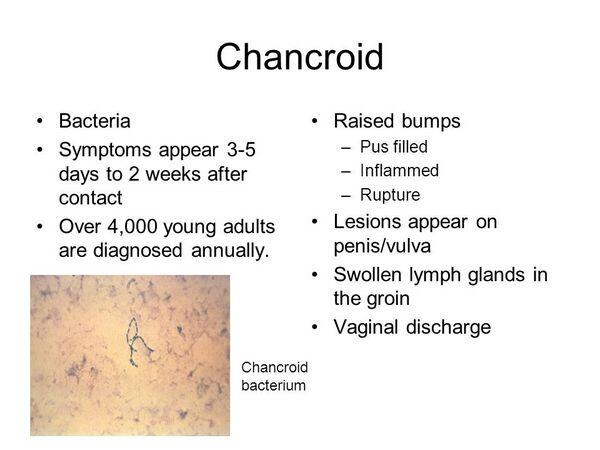Description of Medical Condition
A sexually transmitted disease characterized by painful genital ulcerations and inflammatory inguinal adenopathy. It is uncommon in the United States but found worldwide. Chancroid is endemic in developing countries and a cofactor for HIV transmission.

System(s) affected: Reproductive, Skin/Exocrine
Genetics: N/A
Incidence/Prevalence in USA: Fewer than 100 cases reported to the CDC in 2000-2002. Actual numbers felt to be greater due to underreporting of cases.
Predominant age: Teenagers and adults
Predominant sex: Male > Female
Medical Symptoms and Signs of Disease
- Tender genital papule that ulcerates after 24 hours
- Irregular edged, painful ulcer(s)
- Ulcers may be 1 mm to 5 cm in size
- Ulcers may occur on the shaft of the penis, glans and meatus in men
- Ulcers in women most commonly occur in labia majora but also seen in labia minora, perineum, thigh, and cervix
- Painful inguinal adenopathy with abscess (bubo) formation in 30% of patients
- Atypical presentations include folliculitis and foreskin abscess
What Causes Disease?
Haemophilus ducreyi (gram negative bacterium)
Risk Factors
- Multiple sexual partners
- Uncircumcised males
- Prostitutes often are carriers
Diagnosis of Disease
Differential Diagnosis
- Syphilis
- Herpes simplex virus (HSV1 and 2)
- Lymphogranuloma venereum (LGV)
- Granuloma inguinale
Laboratory
Serologic testing for antibody with ELISA technique. Gram stain; culture of organism on Mueller-Hinton agarwith incorporated vancomycin. Polymerase chain reaction (PCR) where available.
Drugs that may alter lab results: Previous antibiotics
Disorders that may alter lab results: None expected
Pathological Findings
“School of fish” pattern on gram stain
Diagnostic Procedures
- Gram stain and culture of ulcer exudate
- Aspiration of inguinal bubo (lymph node)
- PCR testing of ulcer exudate for H. Ducreyi DNA
- Dark-field examinations of exudate to rule out Trepo-nema pallidum
- Culture or PCR testing for HSV
Treatment (Medical Therapy)
Appropriate Health Care
Outpatient treatment
General Measures
- Saline or Burow’s solution soaks to ulcers
- Aspiration of buboes if greater than 5 cm; done through adjacent uninvolved skin
Activity
Refrain from sexual intercourse until genital lesions fully resolved
Patient Education
- Sexual counseling
- Use of condoms
- Local wound care
- Treatment of all sexual partners with same regimen as index case
- HIV testing
Medications (Drugs, Medicines)
Drug(s) of Choice
- Azithromycin 1 gm po single dose (more expensive than other treatments)
- Ceftriaxone 250 mg IM single dose
- Ciprofloxacin 500 mg po bid for 3 days or other quino-lone
- Erythromycin base 500 mg qid x 7 days
Contraindications:
- Allergy to the medication
- Ciprofloxacin in pregnancy and lactation, and patients less than age 18
Precautions: Refer to manufacturer’s profile of each drug
Significant possible interactions: Refer to manufacturer’s profile of each drug
Alternative Drugs
N/A
Patient Monitoring
- Patient followed until all clinical signs of infection resolved
- Should see symptomatic improvement within 3 days and objective improvement by day 7
- Baseline syphilis serology and at 3 months
- HIV testing at baseline and at 3 months post-treatment
Prevention / Avoidance
Avoidance of sexual activity until ulcers resolved
Possible Complications
- Phimosis
- Balanoposthitis
- Rupture of buboes with fistula formation and scarring
Expected Course / Prognosis
- Full clinical resolution with appropriate treatment
- 5% relapse after treatment
- Primary infection is not believed to provide immunity
Miscellaneous
Associated Conditions
- Syphilis — concurrently in 10% of patients (per new CDC data)
- HSV or HIV infection
Age-Related Factors
N/A
Pediatric: N/A
Geriatric: N/A
Others: HIV disease may affect treatment response
Pregnancy
Maternal to infant transmission has not been reported
Synonyms
- Soft chancre
• Ulcus molle
International Classification of Diseases
099.0 Chancroid
See Also
Syphilis
Other Notes
Chancroid has been shown to be an established risk factor for acquisition of HIV infection





